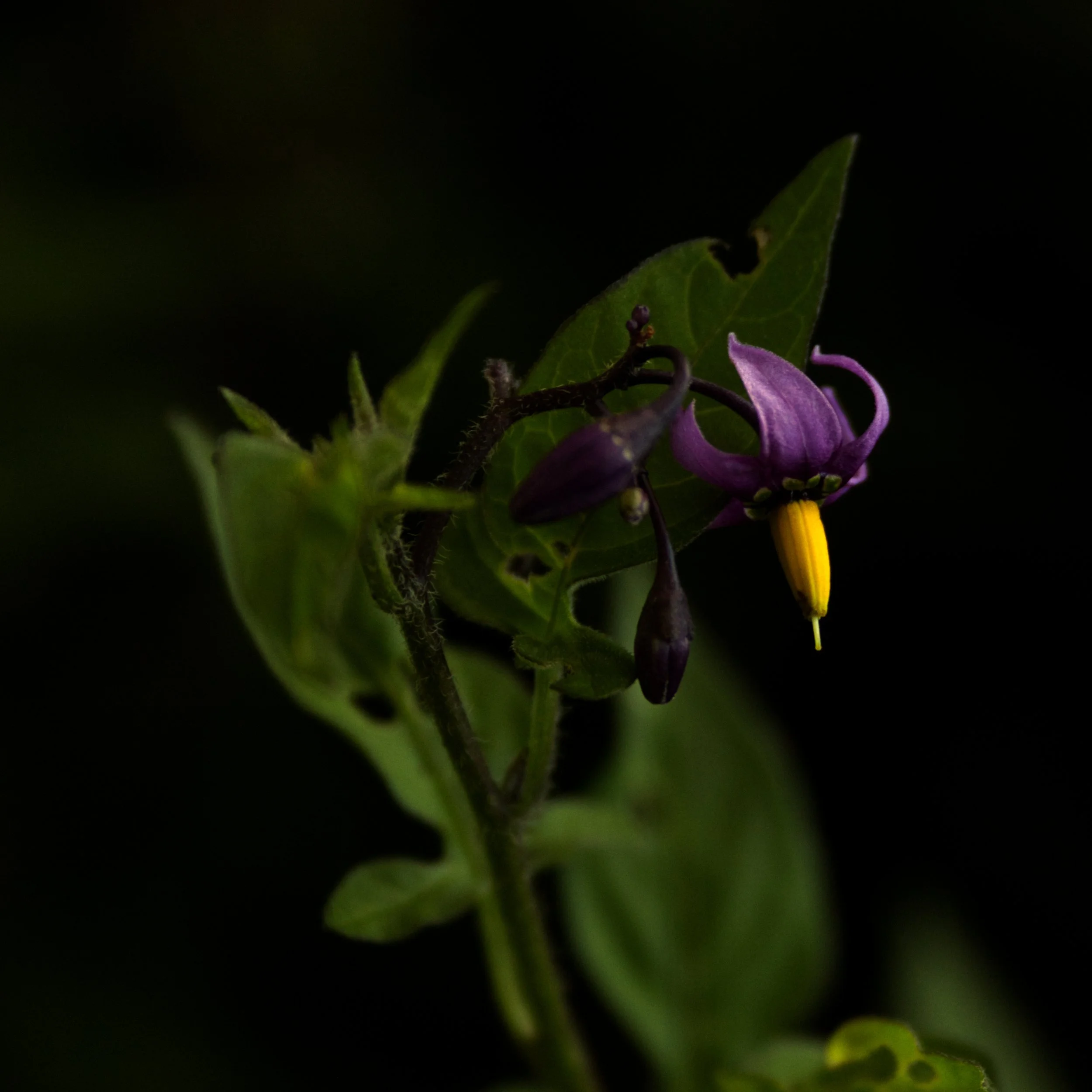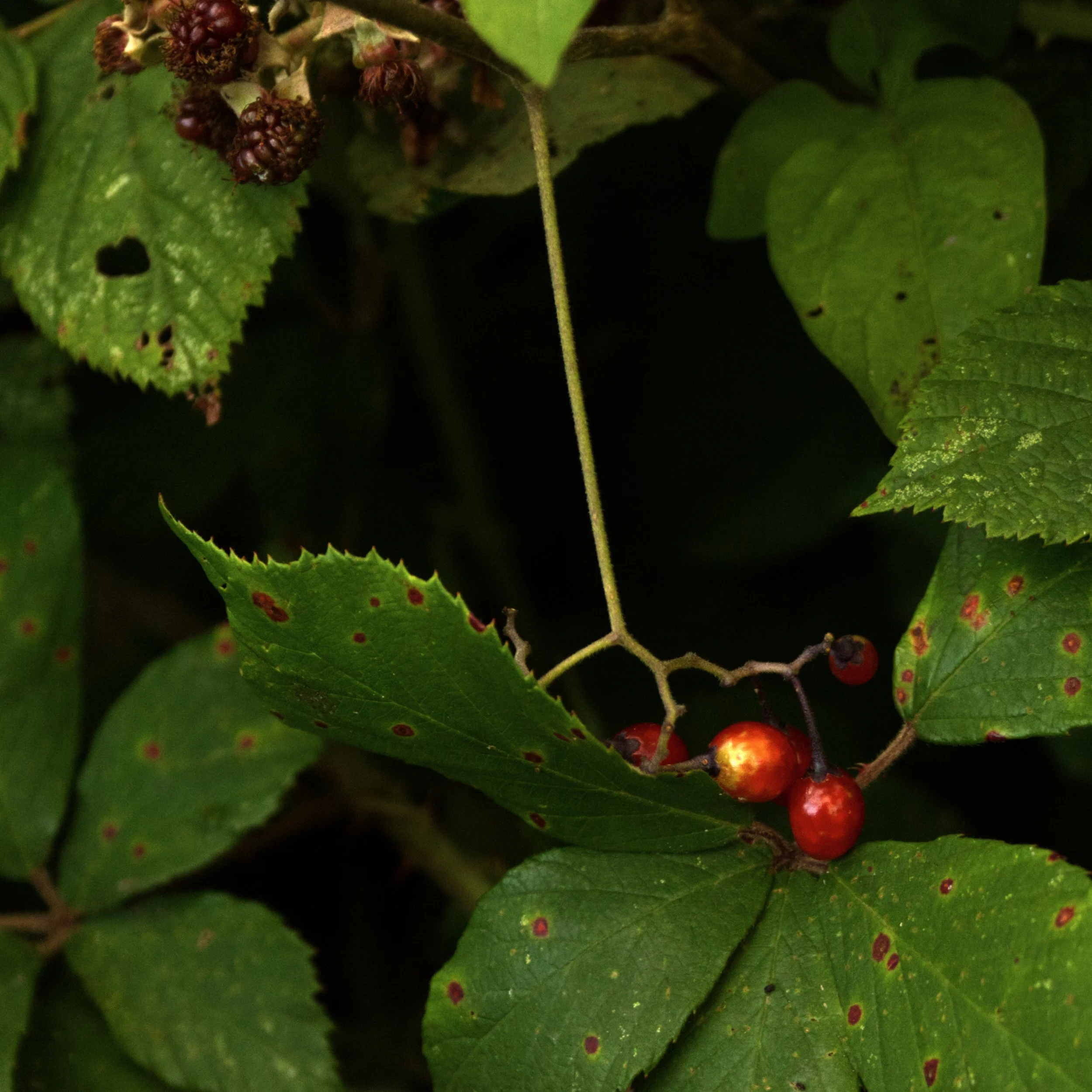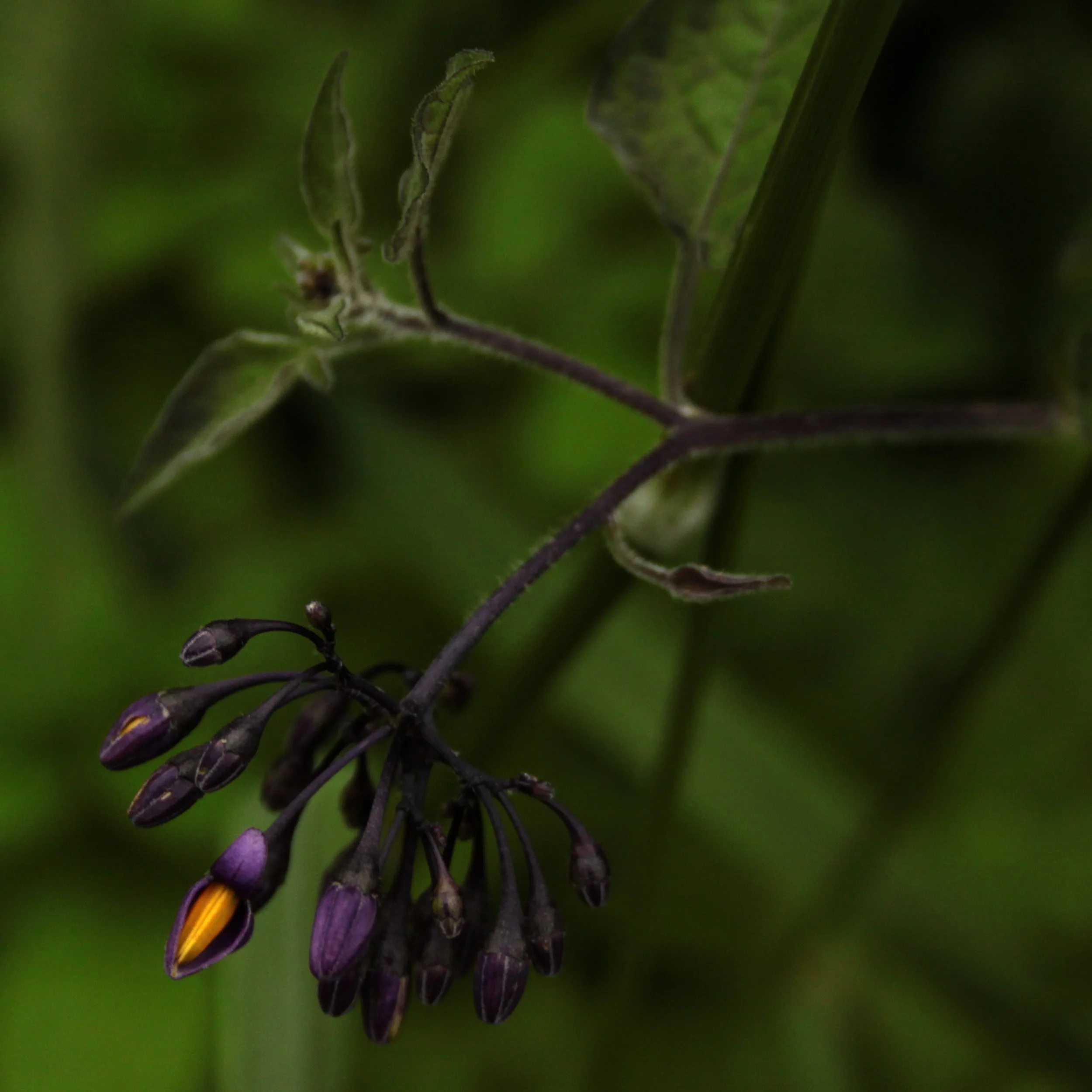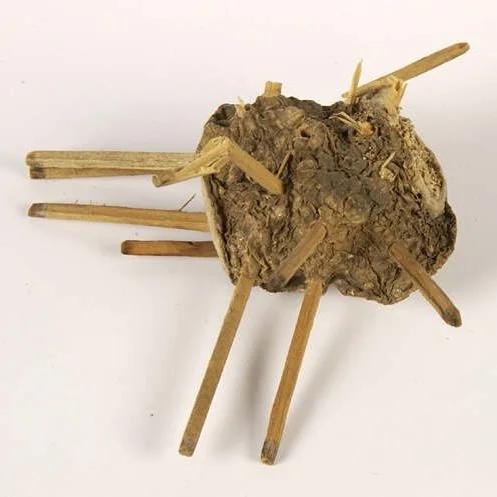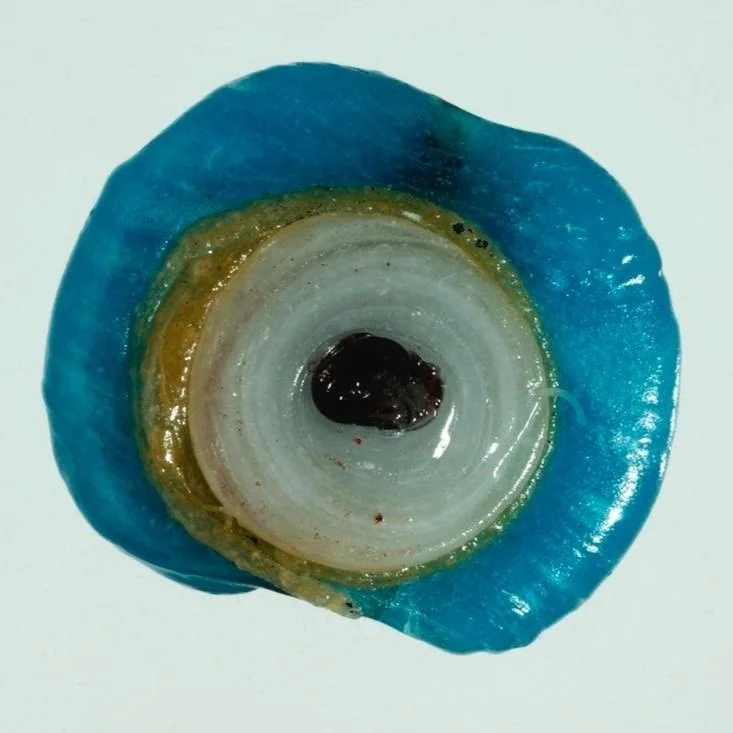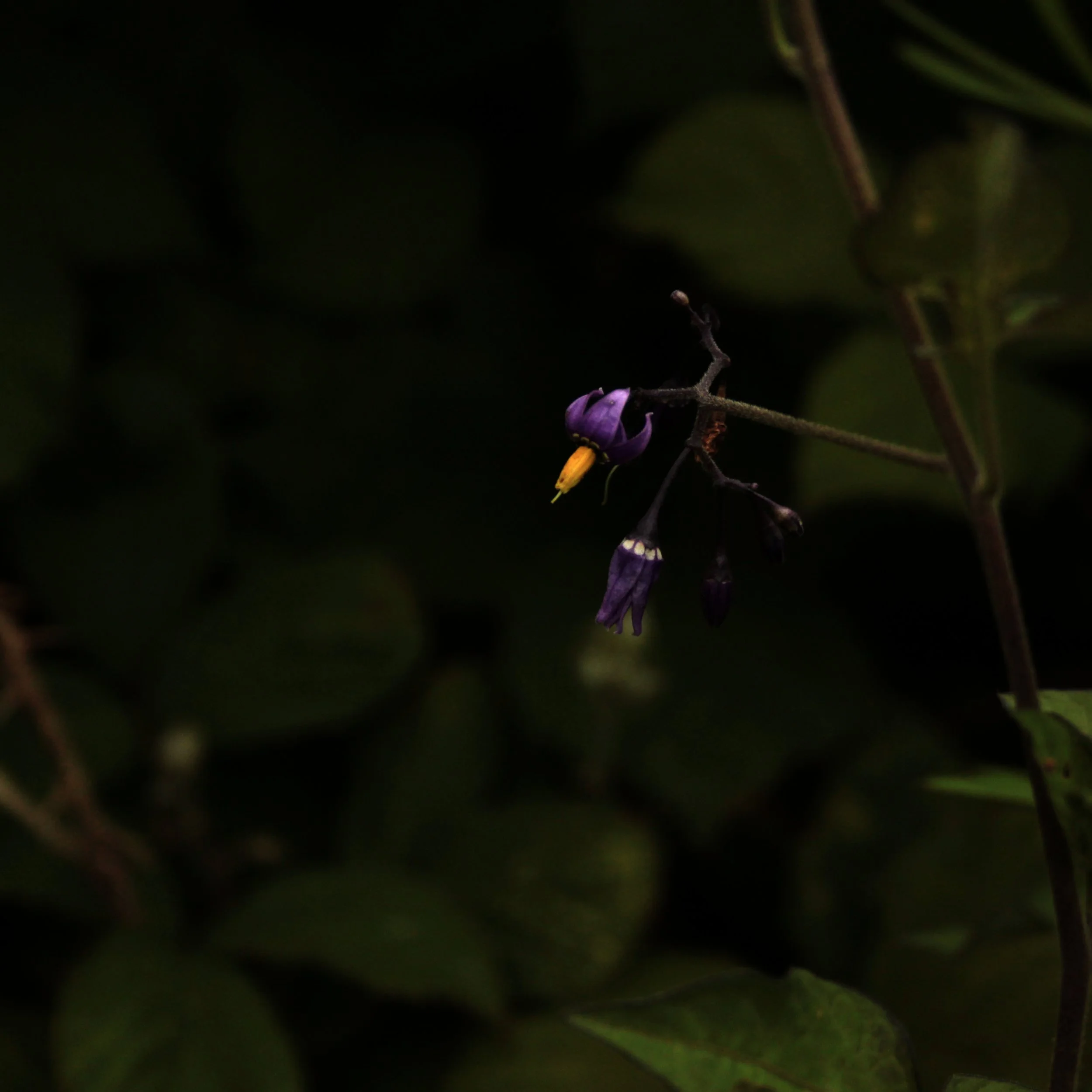September 12th 2024
Elinog: Pigs, Fidelity and the Evil Eye
Welsh common names: Codwarth Caled, Elinog, Mochlys, Manyglog, Chwerw-melys
English common names: Woody nightshade, Bittersweet
Scientific name: Solanum dulcamara
Entwining tendrils around branches and brambles, the plant wraps itself around the limbs of others; moving through hedgerows and thorny scrub, sporting angular stems with clusters of small but striking blooms, appearing from June to October. The star-shaped flowers give way to smooth, poisonous berries that emerge green, flushing orange then red. Not as dangerous as its cousin Deadly Nightshade, the berries of Woody Nightshade are toxic and can be harmful for children as they look edible when ripe, resembling mini tomatoes.
The scientific name Dulcamara literally means ‘sweet-bitter’, in reference to the berries, which initially have a very bitter taste followed by sweetness - hence the common English name Bittersweet, and the Welsh Chwerw-melys; chwerw meaning bitter, and melys, sweet. This led to the plant becoming a symbol of fidelity and marriage, and Woody Nightshade was historically used in bridal bouquets, as well as being featured in various Christian artworks, including decorating the ceiling of 15th century St Thomas church in Leipzig, Germany, where composer Johan Sebastian Bach served as musical director, and where his remains are kept.
Interior of St Thomas church, featuring the organ. Different plants - including bittersweet - can be seen painted between the red vaults. Image source: Wikimedia commons.
The Welsh Elinog means elbow, or ‘angular stem’ in botany, while Manyglog translates to ‘place of shade or cover’, likely describing the kind of environment the plant is often encountered in. Codwarth Caled, seems to literally translate to the incredible name ‘bitter witch’s pubic-hair’ (I really hope this is correct). Codwarth descends from cedowrach, or codowrach, both comprised of cedor; meaning pubic-hair or private-parts, and gwrach; meaning witch, hag, sorceress, and any kind of powerful, undesirable, and therefore fearsome older woman. Caled translates to several things including ‘bitter’, understandably distinguishing these witch’s pubic-hairs from other not-so-bitter witch’s pubic-hairs, as the term also refers to Burdock, Horse tail, Belladonna and Deadly Nightshade. I’d be fascinated to know exactly how this name came into common usage, but maybe it’s not that hard to imagine. Given the way the plant’s tendrils curl and twist, the comparison with pubic-hair is pretty apt, and the association with witches isn’t surprising due to the poisonous berries and therefore ominous nature of Nightshade plants; the possibility of toxic potions enough to arouse fear and suspicion amongst Welsh country folk.
A plant of contradictions, Bittersweet berries were also historically believed to have magical properties and were employed to ward off evil, specifically the ‘evil eye’; a malicious stare born from envy, intended to curse the recipient. An ancient belief held by many cultures, the 3rd century Greek novel Aethiopica (written by Heliodorus of Emesa) explains the ocular phenomenon as:
“When any one looks at what is excellent with an envious eye he fills the surrounding atmosphere with a pernicious quality, and transmits his own envenomed exhalations into whatever is nearest to him.”
Wales was not immune from the presence of the evil eye - llygad drwg - and various charms were fashioned for protection such as this ‘pierced potato’, found hanging above a bed of peas in a Carmarthen garden in 1910; a ritual the family had maintained for generations.
Remains of the 1910 potato charm found in Carmarthen, studded with matchsticks. Image source: People’s Collection Wales, https://www.peoplescollection.wales/items/1845#?xywh=8%2C-18%2C727%2C533
Another evil eye charm from the Amgueddfa Cymru collection, crudely resembling the typical blue glass nazar found in Middle Eastern countries. Unfortunately, no information is included with this object, so when or where it was found, including whether in or out of Wales, is a mystery. Image source: https://museum.wales/collections/online/object/34cb0407-3c6f-3531-a138-498593068c0a/Evil-eye-charm/
In England, curling vines were fashioned into collars and hung around the necks of animals to aid them in specific ways: a nightshade necklace could supposedly cure ‘hagridden’ horses, protect cows from evil, and nurture ‘overlooked’ pigs. Mochlys, translates to pig/swine-plant, inferring the plant was used in a similar fashion with farm animals in Wales.
Additional English common names include: Brook Brimble, Poison-Berry, Lady’s Necklace, Witch Flower, Terri-diddle, Mad Dog’s Berries, Scaw-coo (in Cornwall), Felon-wort and Guinea-goul in county Limerick.
Felon-wort is so named from the plant’s use in healing whitlows - an abscess in the finger - which was historically known as ‘felons', from the Latin fel, meaning bile. The berries were rubbed over the infected area and said to speed healing.
John Gerard’s 1597 Herball details further virtues of Woody Nightshade:
'The juice is good for those that have fallen from high places, and have been thereby bruised or beaten, for it is thought to dissolve blood congealed or cluttered anywhere in the intrals and to heale the hurt places.’
While toxic if ingested by humans or farm animals, the berries of Solanum dulcamara are a main food source for blackcaps, and contribute to the diets of blackbirds, starlings, robins, spotted flycatchers and thrushes.
Translations made using Geiriadur Prifysgol Cymru: https://geiriadur.ac.uk/gpc/gpc.html
Photos by Esther Williams, taken in Hook, Pembrokeshire.
Disclaimer: don’t consume or use wild plants for health purposes without speaking to a medical professional first. Be cautious if foraging and only gather plants that you are certain of. These essays are intended to pique interest rather than act as a robust edible or medicinal guide.
References:
Flowers and Fables: A Welsh Herbal by Jocelyn Lawton
Vickery’s Folk Flora by Roy Vickery
Welsh Names of Plants by Dafydd Davies and Arthur Jones
https://museum.wales/collections/online/object/34cb0407-3c6f-3531-a138-498593068c0a/Evil-eye-charm/
https://www.peoplescollection.wales/items/1845#?xywh=8%2C-18%2C727%2C533
https://www.bbc.com/culture/article/20180216-the-strange-power-of-the-evil-eye
https://www.botanical.com/botanical/mgmh/n/nighwo06.html
https://www.wildlifetrusts.org/wildlife-explorer/wildflowers/bittersweet
https://academic.oup.com/jxb/article/60/11/2955/537778?login=false
